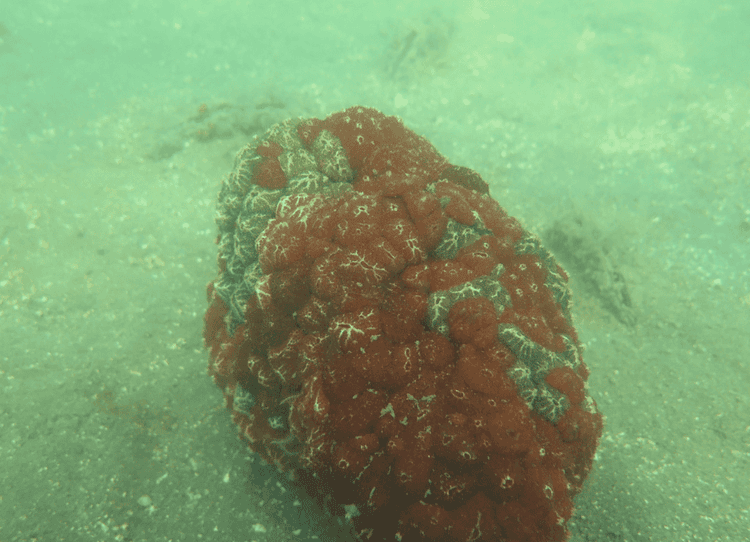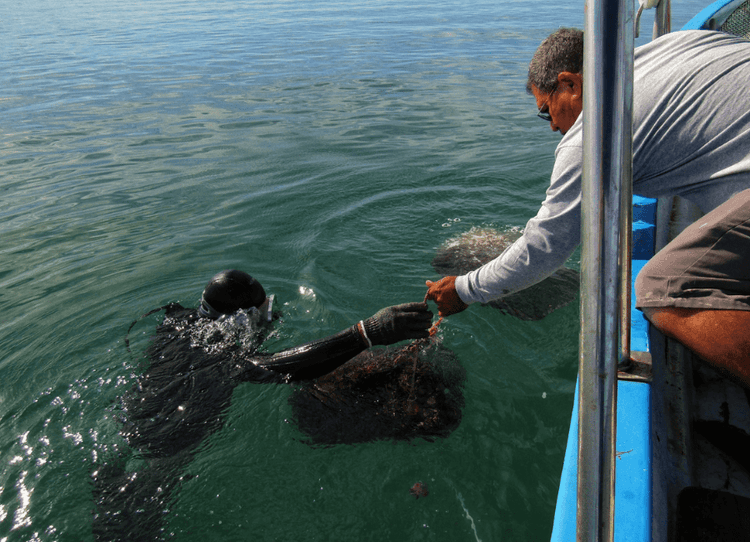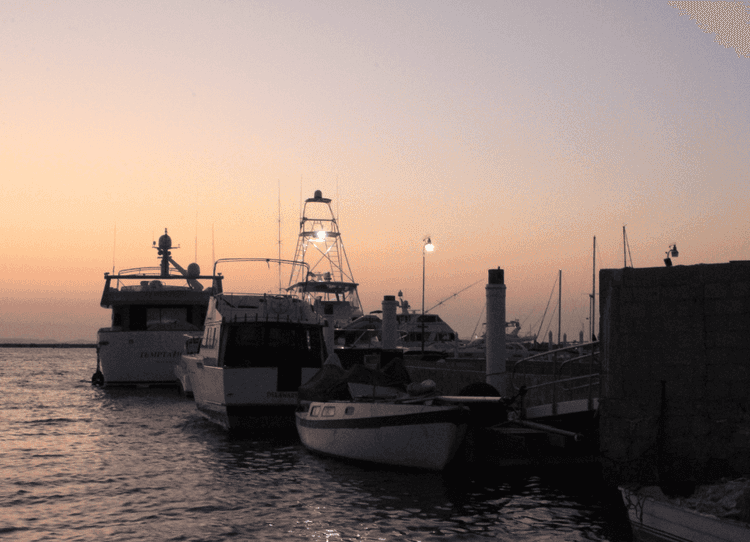The tunicate, a species with a fluffy red and viscous appearance, crossed the Atlantic Ocean through the ballast waters of maritime navigation and reached the cove of La Paz, in northwestern Mexico, causing damage to other species and to aquaculture farms.
The cove of La Paz, Baja California Sur, has ports and marinas with boat traffic from all over the world, so the marina has been the possible introduction of tunicate in La Paz since 2015, according to Andrea Méndez, a marine biologist and coordinator of mangrove restoration at the civil organization Costa Salvaje.
Betzabé Moreno, taxonomist and specialist in ascidia, a class of organisms to which the tunicate belongs, confirmed that it came from the Mediterranean and was present in other parts of the Mexican Caribbean and in Florida, and therefore assures that this invasive species arrived through the ballast waters of a foreign vessel that could be a ship or a sailboat that had transited the Panama Canal.
Ballast water is essential for the safety and efficiency of vessels, since it acts as a heavy material to increase their weight and stabilize them at sea, and when released, they make them lighter, according to the International Maritime Organization (IMO), a specialized agency of the United Nations for the safety and security of navigation and the prevention of marine pollution by ships.
Although at the time the tunicate seemed harmless, in 2016 it grew abruptly and began to suffocate axe calluses, causing massive mortality in 2017, which resulted in a high loss for traditional fishermen.
The presence of the tunicate has been reported in other places, including in some areas of the Bay of La Paz, but it has not been classified as an invasive species, since it has not acted in the way it did in the cove, declared a Ramsar site.
“The tunicate was observed growing massively on the valves (both shells of the specimen) of three species of axe callus, hindering the processes of respiration, filtration and reproduction. When it covers the valves completely, it causes their death due to general deterioration of the physiological condition, suffocation and starvation,” Méndez said in his thesis (2023).
The invasion caused a high mortality of organisms and a reduction of almost 75% of the axe callus population, according to data reported in the Protocol for Early Detection and Rapid Response to the Presence of Tunicates (DTRR), developed by Silvia Ramírez through the organization Northwest Sustainable (NOS) for projects that work with international funding.
Some of the explanations for why this was the case in the cove, Betzabé explains in her thesis, is that the recovery of axe callus increased the availability of surfaces where the tunicate lives and facilitated its rapid colonization in shell banks.
In addition to the fact that 2016, when there was a considerable increase in tunicate, was a year in which the temperature of the sea was very high and that could favor the reproduction of these organisms, which, since they do not have natural predators, imbalance the ecosystem, says the protocol.
Andrea Méndez points out that another important factor that may have influenced its spread are dredging activities in the cove, which dispersed the tunicate near the axe callus banks.
First frustrated harvest in 2017
In 2011, a group of 109 fishermen that are now constituted as the Fishermen's Organization Rescuing the Cove (OPRE), accompanied by the Northwest Sustainable Organization (NOS), reached an agreement not to extract callus from an axe, a resource that had been exhausted for 10 years, to regenerate it in the cove of La Paz as part of a restoration project.
At that time, 60,000 axe calluses were registered in the cove, which three years later numbered 3 million, thanks to the cessation of fishing and community surveillance of women, says Hubert Mendez, a fisherman who is a member of OPRE in a short documentary that was made to show the restoration of the cove.
In 2017, after six harvests without extracting axe callus, they were authorized to extract 278 thousand organisms, but the tunicate surprised them and they only completed 110 thousand 486, corresponding to 3.1 tons, according to Ramirez, and around 177 thousand tons of wet weight of tunicate. It is estimated that around two million calluses were lost due to tunicate suffocation and other natural phenomena.

Photograph of an axe callus completely wrapped in a tunicate on the seabed of the cove of La Paz. Source: Sustainable Northwest.
Once the invasive species was detected, the fishermen and NOS began working on a project with the National Commission for the Knowledge and Use of Biodiversity (Conabio) to develop the DTRR to mitigate or control tunication.
According to an article by scientist Betzabé Moreno-Davila, efforts to remove the tunicate had been costly, time-consuming and generally ineffective.
Therefore, he recommended removing dead shells and removing or cutting the edges of the tunicated shells in a particular way so that the larvae would not disperse and reproduce.
With the help of Betzabé, the fishermen were trained and specialized and did various practices, until they incorporated it into their routines.
Fishermen went out every day and spent four to five hours eliminating this invasive species manually, callo by callo, to avoid further economic losses.
This extra activity resulted in monetary losses of approximately 5,700 pesos per day, as they invested in cleaning, in costs such as labor and fuel, according to Méndez.
In the end, the tunicate was only removed to the shore, put to dry and discarded, because no risks have been proven outside the sea, the author said in an interview.

OPRE fishermen carrying out tunicate removal work in the La Paz cove. Alejandra Amaya Font
Legal loophole in the inspection of smaller vessels
The theory that the tunicate arrived through a visiting vessel that discharged its ballast water into La Paz Bay is shared by the experts consulted for this report.
Ballast water is the main propagator of foreign viruses and bacteria that can be considered invasive because it threatens native species and human health, making it a global problem, according to the Ministry of Environment and Natural Resources (Semarnat).
The best tool to prevent this, according to the authority, is the regulation of the emptying of ballast water in waters far from the sea of origin so that they can be pre-treated and some filtration and sterilization technologies, among others.
“You have an obligation to release these ballast waters out to sea, precisely to be able to enter and not generate an adverse effect, because there are a lot of organisms in those waters and they reach an environment in which they can not find predators and then they can develop and eventually, as in the case of tunicate, reproduce uncontrollably,” said Silvia Ramírez of the NOS organization.
Currently, there are international regulations. In the case of Mexico, the authority responsible for verifying compliance with the regulations issued by the IMO is the Secretariat of the Navy (Semar), through the Port Authority, the maritime authority in each authorized port, and its functions as Coast Guard.
The Port Authority, in accordance with the Maritime Navigation and Commerce Act, has the power to require certificates and inspect any vessel and to ensure that navigation and maneuvers are carried out in conditions of safety, economy and efficiency.
However, Ricardo Lozano García, Captain of the Port of La Paz and Captain of the Ship, pointed out that these powers belong to him only when it comes to navigation and maritime commerce and, the rest belongs to the inspectors of the Unit of Port Authorities and Maritime Affairs (Unicapam), who have to comply with international legislation, he said.
“Inspections are done to the marina, but they are usually for safety reasons and that they have the necessary and qualified infrastructure, procedures and personnel to service the vessels. Generally, there are pure individuals and of these individuals there is the foreign population that arrives from cabotage and their height they did it in another port and they already arrive here by cabotage and if it becomes a little difficult in the preventive part... and there are even ships that have been here for years and have just been endorsing them, but their regularization as a national one does not specify it, they keep it that way out of convenience. However, let's say it's a hole or a kindness in their favor that the same law gives,” he said.
But the same Law establishes that port captains can impose fines on those who commit violations of international treaties, administrative regulations or official Mexican regulations; and on shipowners of domestic or foreign vessels who commit minor violations.
Silvia Ramírez points out that a large part of the regulation falls to the Harbor Master's Office, since it is the authority that determines the access and permanence of boats in the Bay of La Paz.
The lack of defined powers and responsibilities complicates the prevention and care of invasive species, as happened with the tunicate. According to Betzabé, its spread could have been prevented through internal cleaning and scraping, mainly on smaller boats such as sailboats.
In La Paz, Lozano insisted that it is necessary to improve the national maritime culture and that boat owners are responsible for complying with legislation, and for this reason, more awareness programs are required.
Tuned in control, but the risk remains
Tropical storm Lidia in 2017 and other natural phenomena have worked as a natural control and have helped to counteract the invasion of tunicate in the cove, according to Silvia Ramírez. However, he points out that the callus population was very affected as a result of mortality from tunicate and since 2019, less than 100,000 calluses have been extracted.
“Fortunately, for the callus and for the fishermen, it killed a good amount of tunicate and from there the presence of the tunicate was reduced. Almost every year since 2019, we have been told that a lot has already been controlled, there is no longer much presence, but this year they only informed us that they have observed areas with a lot of tunicate abundance again,” he said.
Therefore, it is important that the companies that manage the marines ensure that conditions are not favored in their spaces for tunicate to grow and disperse, he said.

One of the marinas in the cove of La Paz, Baja California Sur. Source: Daniela Reyes
Méndez stressed that if this happens again, one of the advantages is that fishermen already know how to attack the invasion, unlike six years ago and now, with his thesis, it was found that tunicate has antibacterial potential, so it could be used in the future.
However, experts fear that as soon as it arrived and since it ceased to be a threat, tunicate may once again return and impact the ecosystem and fisheries, especially when the picture indicates that maritime traffic and dredging will continue and that temperatures are increasing as a result of climate change; two factors that brought the tunicate to the cove of La Paz in the first place.



Comentarios (0)